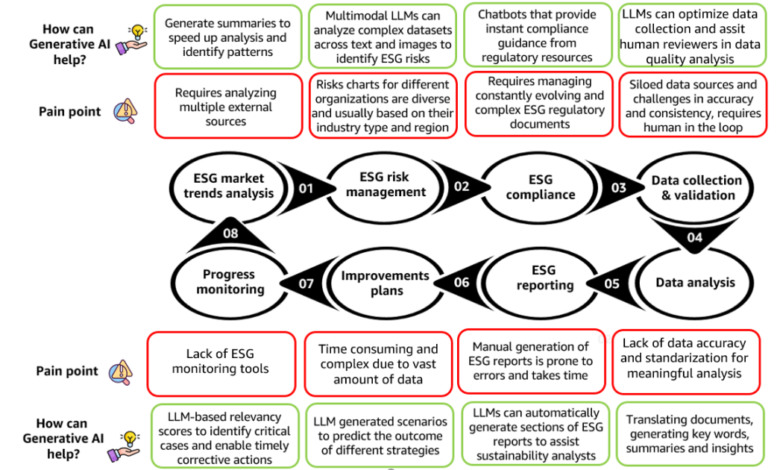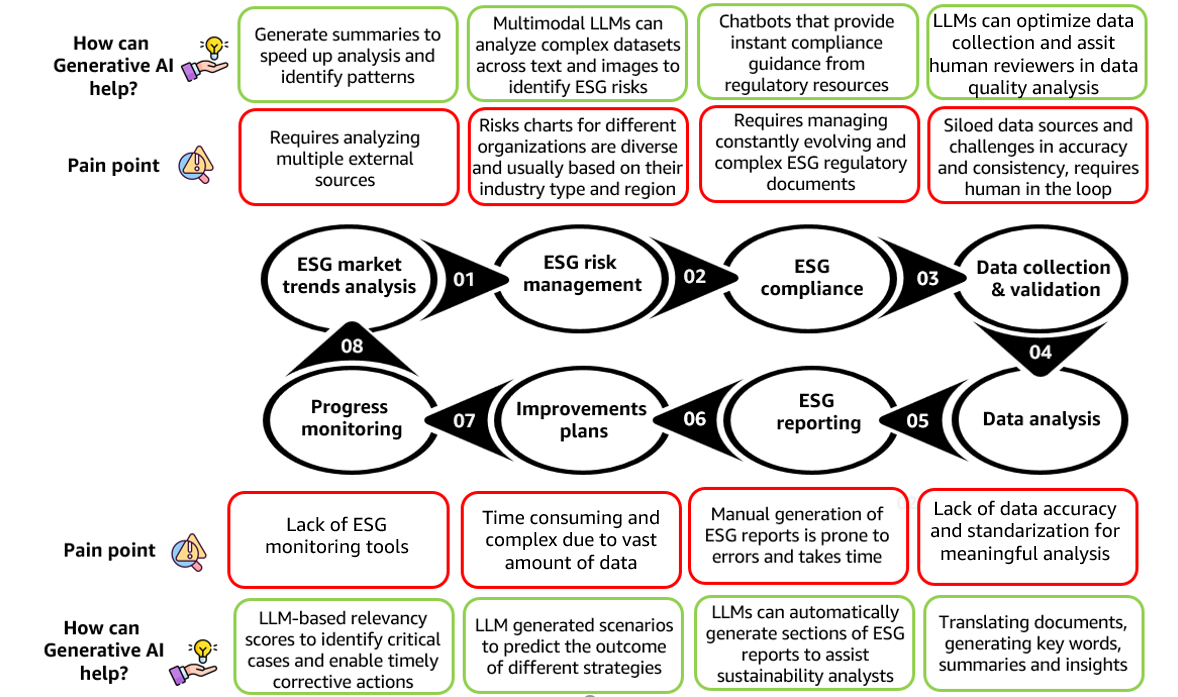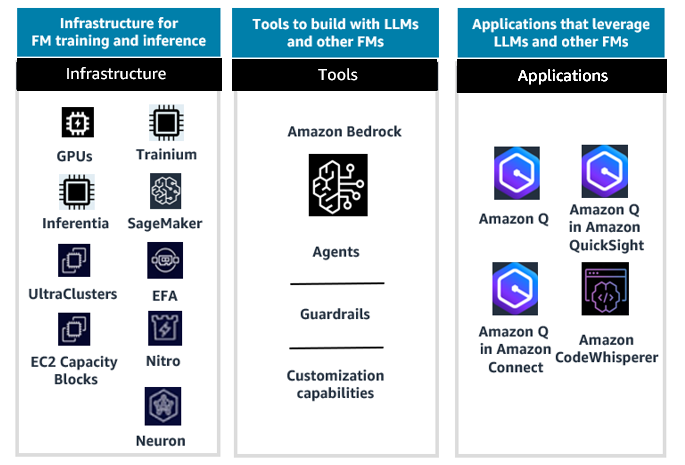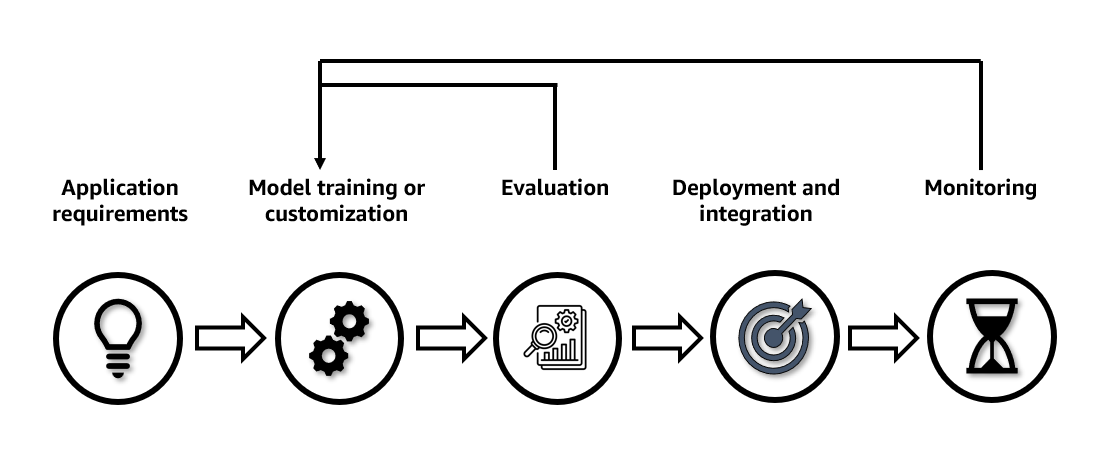The executive’s guide to generative AI for sustainability

Organizations are facing ever-increasing requirements for sustainability goals alongside environmental, social, and governance (ESG) practices. A Gartner, Inc. survey revealed that 87 percent of business leaders expect to increase their organization’s investment in sustainability over the next years. This post serves as a starting point for any executive seeking to navigate the intersection of generative artificial intelligence (generative AI) and sustainability. It provides examples of use cases and best practices for using generative AI’s potential to accelerate sustainability and ESG initiatives, as well as insights into the main operational challenges of generative AI for sustainability. This guide can be used as a roadmap for integrating generative AI effectively within sustainability strategies while ensuring alignment with organizational objectives.
A roadmap to generative AI for sustainability
In the sections that follow, we provide a roadmap for integrating generative AI into sustainability initiatives
1. Understand the potential of generative AI for sustainability
Generative AI has the power to transform every part of a business with its wide range of capabilities. These include the ability to analyze massive amounts of data, identify patterns, summarize documents, perform translations, correct errors, or answer questions. These capabilities can be used to add value throughout the entire value chain of your organization. Figure 1 illustrates selected examples of use cases of generative AI for sustainability across the value chain.
Figure 1: Examples of generative AI for sustainability use cases across the value chain
According to KPMG’s 2024 ESG Organization Survey, investment in ESG capabilities is another top priority for executives as organizations face increasing regulatory pressure to disclose information about ESG impacts, risks, and opportunities. Within this context, you can use generative AI to advance your organization’s ESG goals.
The typical ESG workflow consists of multiple phases, each presenting unique pain points. Generative AI offers solutions that can address these pain points throughout the process and contribute to sustainability efforts. Figure 2 provides examples illustrating how generative AI can support each phase of the ESG workflow within your organization. These examples include speeding up market trend analysis, ensuring accurate risk management and compliance, and facilitating data collection or report generation. Note that ESG workflows may vary across different verticals, organizational maturities, and legislative frameworks. Factors such as industry-specific regulations, company size, and regional policies can influence the ESG workflow steps. Therefore, prioritizing use cases according to your specific needs and context and defining a clear plan to measure success is essential for optimal effectiveness.

Figure 2: Mapping generative AI benefits across the ESG workflow
2. Recognize the operational challenges of generative AI for sustainability
Understanding and appropriately addressing the challenges of implementing generative AI is crucial for organizations aiming to use its potential to address the organization’s sustainability goals and ESG initiatives. These challenges include collecting and managing high-quality data, integrating generative AI into existing IT systems, navigating ethical concerns, filling skills gaps and setting the organization up for success by bringing in key stakeholders such as the chief information security officer (CISO) or chief financial officer (CFO) early so you build responsibly. Legal challenges are a huge blocker for transitioning from proof of concept (POC) to production. Therefore, it’s essential to involve legal teams early in the process to build with compliance in mind. Figure 3 provides an overview of the main operational challenges of generative AI for sustainability.

Figure 3: Operational challenges of generative AI for sustainability
3. Set the right data foundations
As a CEO aiming to use generative AI to achieve sustainability goals, remember that data is your differentiator. Companies that lack ready access to high-quality data will not be able to customize generative AI models with their own data, thus missing out on realizing the full scaling potential of generative AI and creating a competitive advantage. Invest in acquiring diverse and high-quality datasets to enrich and accelerate your ESG initiatives. You can use resources such as the Amazon Sustainability Data Initiative or the AWS Data Exchange to simplify and expedite the acquisition and analysis of comprehensive datasets. Alongside external data acquisition, prioritize internal data management to maximize the potential of generative AI and use its capabilities in analyzing your organizational data and uncovering new insights.
From an operational standpoint, you can embrace foundation model ops (FMOps) and large language model ops (LLMOps) to make sure your sustainability efforts are data-driven and scalable. This involves documenting data lineage, data versioning, automating data processing, and monitoring data management costs.
4. Identify high-impact opportunities
You can use Amazon’s working backwards principle to pinpoint opportunities within your sustainability strategy where generative AI can make a significant impact. Prioritize projects that promise immediate enhancements in key areas within your organization. While ESG remains a key aspect of sustainability, tapping into industry-specific expertise across sectors such as energy, supply chain, and manufacturing, transportation, or agriculture can uncover diverse generative AI for sustainability use cases tailored to your business’s applications. Moreover, exploring alternative avenues, such as using generative AI for improving research and development, enabling customer self-service, optimizing energy usage in buildings or slowing down deforestation, can also provide impactful opportunities for sustainable innovation.
5. Use the right tools
Failing to use the appropriate tools can add complexity, compromise security, and reduce effectiveness in using generative AI for sustainability. The right tool should offer you choice and flexibility and enable you to customize your solutions to specific needs and requirements.
Figure 4 illustrates the AWS generative AI stack as of 2023, which offers a set of capabilities that encompass choice, breadth, and depth across all layers. Moreover, it is built on a data-first approach, ensuring that every aspect of its offerings is designed with security and privacy in mind.
Examples of tools you can use to advance sustainability initiatives are:
Amazon Bedrock – a fully managed service that provides access to high-performing FMs from leading AI companies through a single API, enabling you to choose the right model for your sustainability use cases.
AWS Trainium2 – Purpose-built for high-performance training of FMs and LLMs, Trainium2 provides up to 2x better energy efficiency (performance/watt) compared to first-generation Trainium chips.
Inferentia2-based Amazon EC2 Inf2 instances – These instances offer up to 50 percent better performance/watt over comparable Amazon Elastic Compute Cloud (Amazon EC2) instances. Purpose-built to handle deep learning models at scale, Inf2 instances are indispensable for deploying ultra-large models while meeting sustainability goals through improved energy efficiency.

Figure 4: AWS generative AI stack
6. Use the right approach
Generative AI isn’t a one-size-fits-all solution. Tailoring your approach by choosing the right modality and optimization strategy is crucial for maximizing its impact on sustainability initiatives. Figure 5 offers an overview on generative AI modalities and optimization strategies, including prompt engineering, Retrieval Augmented Generation, and fine-tuning or continued pre-training.

Figure 5: Generative AI modalities
In addition, figure 6 outlines the main generative AI optimization strategies, including prompt engineering, Retrieval Augmented Generation, and fine-tuning or continued pre-training.

Figure 6: Generative AI optimization strategies
7. Simplify the development of your applications by using generative AI agents
Generative AI agents offer a unique opportunity to drive sustainability initiatives forward with their advanced capabilities of automating a wide range of routine and repetitive tasks, such as data entry, customer support inquiries, and content generation. Moreover, they can orchestrate complex, multistep workflows by breaking down tasks into smaller, manageable steps, coordinating various actions, and ensuring the efficient execution of processes within your organization. For example, you can use Agents for Amazon Bedrock to configure an agent that monitors and analyzes energy usage patterns across your operations and identifies opportunities for energy savings. Alternatively, you can create a specialized agent that monitors compliance with sustainability regulations in real time.
8. Build robust feedback mechanisms for evaluation
Take advantage of feedback insights for strategic improvements, whether adjusting generative AI models or redefining objectives to ensure agility and alignment with sustainability challenges. Consider the following guidelines:
Implement real-time monitoring – Set up monitoring systems to track generative AI performance against sustainability benchmarks, focusing on efficiency and environmental impact. Establish a metrics pipeline to provide insights into the sustainability contributions of your generative AI initiatives.
Engage stakeholders for human-in-the-loop evaluation – Rely on human-in-the-loop auditing and regularly collect feedback from internal teams, customers, and partners to gauge the impact of generative AI–driven processes on the organization’s sustainability benchmarks. This enhances transparency and promotes trust in your commitment to sustainability.
Use automated testing for continuous improvement – With tools such as RAGAS and LangSmith, you can use LLM-based evaluation to identify and correct inaccuracies or hallucinations, facilitating rapid optimization of generative AI models in line with sustainability goals.
9. Measure impact and maximize ROI from generative AI for sustainability
Establish clear key performance indicators (KPIs) that capture the environmental impact, such as carbon footprint reduction, alongside economic benefits, such as cost savings or enhanced business agility. This dual focus ensures that your investments not only contribute to programs focused on environmental sustainability but also reinforces the business case for sustainability while empowering you to drive innovation and competitive advantage in sustainable practices. Share success stories internally and externally to inspire others and demonstrate your organization’s commitment to sustainability leadership.
10. Minimize resource usage throughout the generative AI lifecycle
In some cases, generative AI itself can have a high energy cost. To achieve maximum impact, consider the trade-off between the benefits of using generative AI for sustainability initiatives and the energy efficiency of the technology itself. Make sure to gain a deep understanding of the iterative generative AI lifecycle and optimize each phase for environmental sustainability. Typically, the journey into generative AI begins with identifying specific application requirements. From there, you have the option to either train your model from scratch or use an existing one. In most cases, opting for an existing model and customizing it is preferred. Following this step and evaluating your system thoroughly is essential before deployment. Lastly, continuous monitoring enables ongoing refinement and adjustments. Throughout this lifecycle, implementing AWS Well-Architected Framework best practices is recommended. Refer to Figure 7 for an overview of the generative AI lifecycle.

Figure 7: The generative AI lifecycle
11. Manage risks and implement responsibly
While generative AI holds significant promise for working towards your organization’s sustainability goals, it also poses challenges such as toxicity and hallucinations. Striking the right balance between innovation and the responsible use of generative AI is fundamental for mitigating risks and enabling responsible AI innovation. This balance must account for the assessment of risk in terms of several factors such as quality, disclosures, or reporting. To achieve this, adopting specific tools and capabilities and working with your security team experts to adopt security best practices is necessary. Scaling generative AI in a safe and secure manner requires putting in place guardrails that are customized to your use cases and aligned with responsible AI policies.
12. Invest in educating and training your teams
Continuously upskill your team and empower them with the right skills to innovate and actively contribute to achieving your organization’s sustainability goals. Identify relevant resources for sustainability and generative AI to ensure your teams stay updated with the essential skills required in both areas.
Conclusion
In this post, we provided a guide for executives to integrate generative AI into their sustainability strategies, focusing on both sustainability and ESG goals. The adoption of generative AI in sustainability efforts is not just about technological innovation. It is about fostering a culture of responsibility, innovation, and continuous improvement. By prioritizing high-quality data, identifying impactful opportunities, and fostering stakeholders’ engagement, companies can harness the transformative power of generative AI to not only achieve but surpass their sustainability goals.
How can AWS help?
Explore the AWS Solutions Library to discover ways to build sustainability solutions on AWS.
The AWS Generative AI Innovation Center can assist you in the process with expert guidance on ideation, strategic use case identification, execution, and scaling to production.
To learn more about how Amazon is using AI to reach our climate pledge commitment of net-zero carbon by 2040, explore the 7 ways AI is helping Amazon build a more sustainable future and business.
About the Authors
 Dr. Wafae Bakkali is a Data Scientist at AWS. As a generative AI expert, Wafae is driven by the mission to empower customers in solving their business challenges through the utilization of generative AI techniques, ensuring they do so with maximum efficiency and sustainability.
Dr. Wafae Bakkali is a Data Scientist at AWS. As a generative AI expert, Wafae is driven by the mission to empower customers in solving their business challenges through the utilization of generative AI techniques, ensuring they do so with maximum efficiency and sustainability.
 Dr. Mehdi Noori is a Senior Scientist at AWS Generative AI Innovation Center. With a passion for bridging technology and innovation in the sustainability field, he assists AWS customers in unlocking the potential of Generative AI, turning potential challenges into opportunities for rapid experimentation and innovation. By focusing on scalable, measurable, and impactful uses of advanced AI technologies and streamlining the path to production, he helps customers achieve their sustainability goals.
Dr. Mehdi Noori is a Senior Scientist at AWS Generative AI Innovation Center. With a passion for bridging technology and innovation in the sustainability field, he assists AWS customers in unlocking the potential of Generative AI, turning potential challenges into opportunities for rapid experimentation and innovation. By focusing on scalable, measurable, and impactful uses of advanced AI technologies and streamlining the path to production, he helps customers achieve their sustainability goals.
 Rahul Sareen is the GM for Sustainability Solutions and GTM at AWS. Rahul has a team of high performing individuals consisting of sustainability strategists, GTM specialists and technology architects to create great business outcomes for customer’s sustainability goals (everything from carbon emission tracking, sustainable packaging and operations, circular economy to renewable energy). Rahul’s team provides technical expertise (ML, GenAI, IoT) to solve sustainability use cases
Rahul Sareen is the GM for Sustainability Solutions and GTM at AWS. Rahul has a team of high performing individuals consisting of sustainability strategists, GTM specialists and technology architects to create great business outcomes for customer’s sustainability goals (everything from carbon emission tracking, sustainable packaging and operations, circular economy to renewable energy). Rahul’s team provides technical expertise (ML, GenAI, IoT) to solve sustainability use cases



